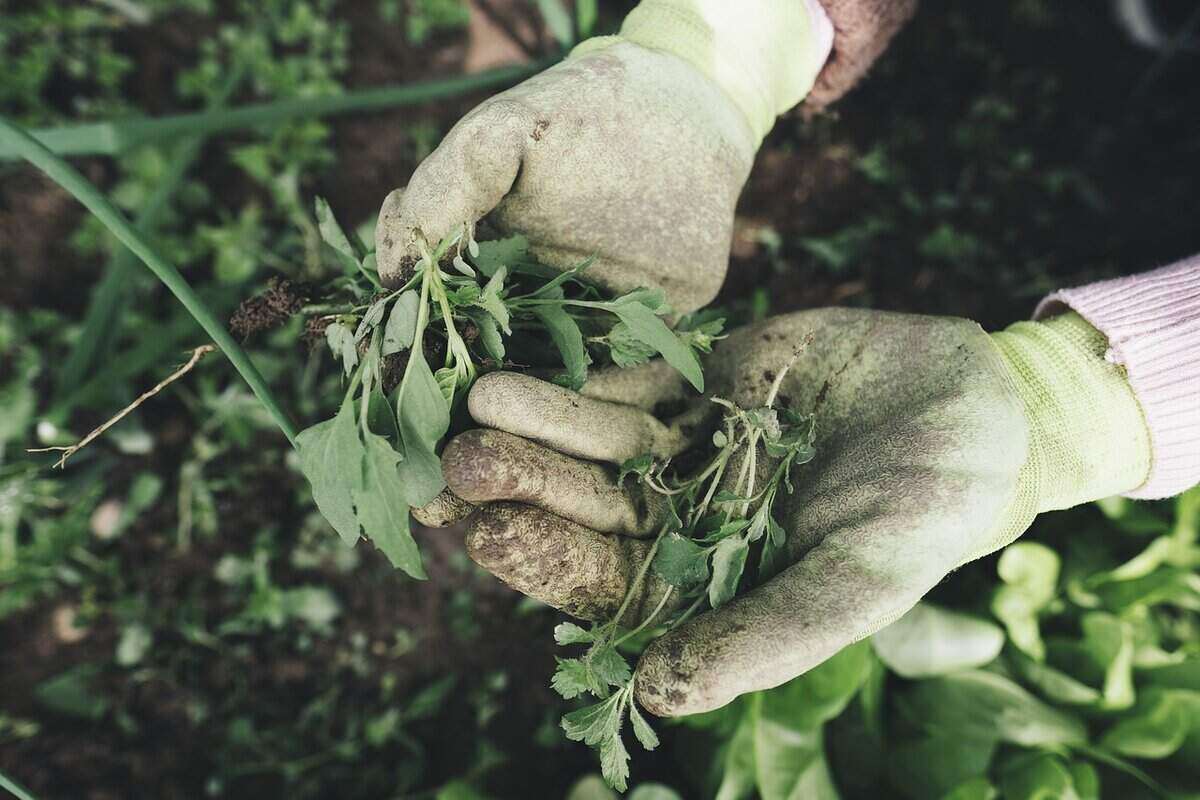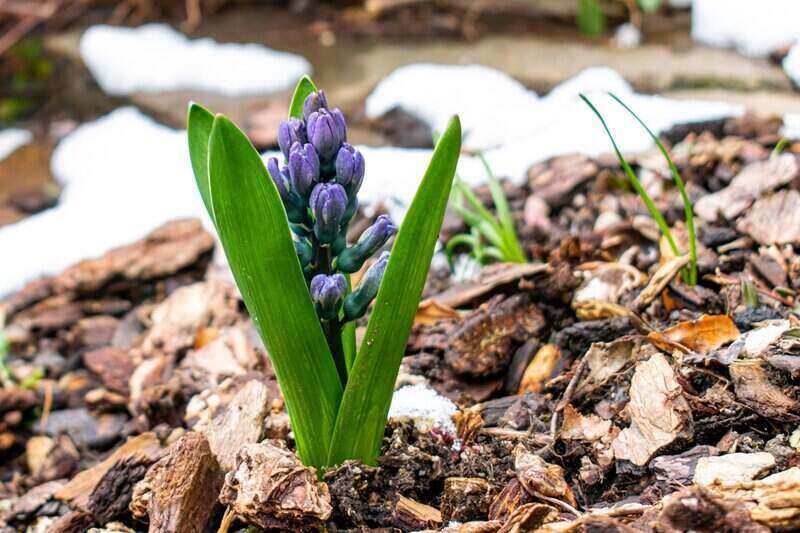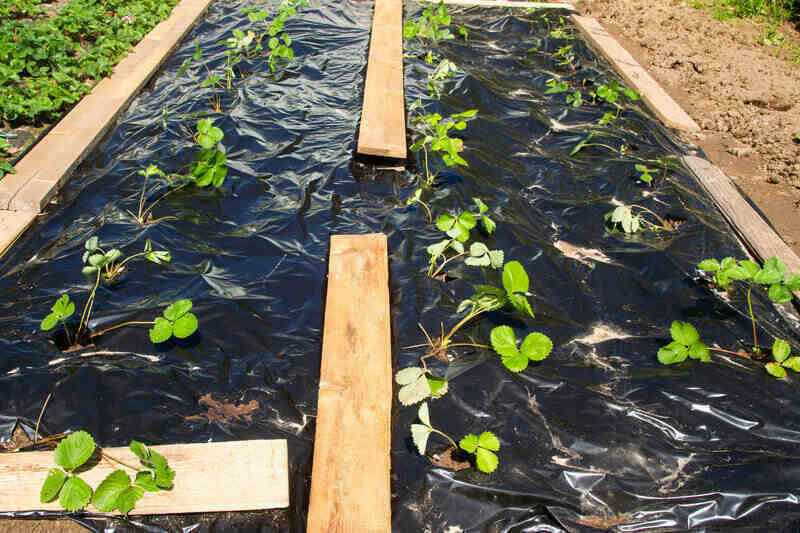
Weeds are a serious pain in the grass. But as tempting as it is to grab the bottle of chemical weed killers, don’t do it. Chemical weed killers are incredibly harmful to you, your family, your pets, and the environment, especially critical pollinators like bees and butterflies. Instead, choose one of these 11 non-toxic ways to kill weeds. It’s safer, cheaper, and more effective.

11 Non-toxic ways to kill weeds
Chemical weed killers are easy and effective, but their chemicals are dangerous for you, your family, your pets, and the environment. But what else can you use that’s just as easy and effective? Lots of things! Read on for 11 effective non-toxic ways to kill weeds.
1. Mulch

If your garden bed is riddled with weeds, try mulch. Believe it or not, there are tons of types of mulch, both organic and inorganic. Mulch works by blocking sunlight and stopping new weed seeds from sprouting. A thick layer of mulch (thickness depends on type) ensures that any breakthrough weeds are easier to remove since their roots won’t be as deep.
The major difference between the two is organic mulch adds nutrients to your soil, but inorganic mulch is typically more effective against weeds. Organic mulch needs to be replaced more often, but inorganic mulch is usually more expensive.
Types of organic mulch include
- Wood chips
- Pine needles
- Wood mulch
Types of inorganic mulch include
- Rocks
- Rubber mulch
- Gravel
Pros of mulch:
✓ Attractive
✓ Nutritious
✓ Encourages earthworms that create healthy soil
✓ Regulates temperature
✓ Retains moisture
Cons of mulch:
✗ Some organic mulch can be stinky
✗ Dyes used to color mulch (usually red or black) can stain
✗ Mulch also can harbor other pests like slugs, cutworms, and earwigs that might threaten plants
2. Hand weeding

Weeding might be tedious – or it might just be the best free therapy you have in an increasingly chaotic world.
If it seems like you’re never gaining ground against these lawn and garden invaders, don’t stress. Weeds are the equivalent of a plant cockroach. They’re always going to survive in the end. So why worry? Next time you feel like you need a break, go outside and weed. It’s the most natural way to get rid of unwanted plants.
When weeding by hand, you’ll need to make sure you grab the entire weed, taproots and all, or it will return.
Pros of hand weeding:
✓ No special equipment needed, just hands
✓ Gets the entire weed
✓ Instant
Cons of hand weeding::
✗ Time-consuming
✗ Tedious manual labor
3. Landscape fabric

Gardeners use landscape fabric to smother weed seeds and block the sun and air they need to grow. The woven sheet of fabric is sold in long black rolls with perforated holes to let water through. Rolls are about 3 feet wide and more than 200 feet long. Cost varies depending on the brand and thickness of the landscape fabric.
Pros of landscape fabric:
✓ Useful for prohibiting weeds around trees and shrubs, topped with mulch
Cons of landscape fabric:
✗ Unattractive. The tarp appearance might make your yard look like a giant Slip N’ Slide unless landscape fabric is hidden under landscaping rocks or mulch.
✗ It’s not recommended for vegetable gardens or annual flower beds because landscape fabric stays in place for years.
4. Landscape fabric alternatives

Landscape fabric is excellent for weed control, but it’s not appropriate for all gardens. Gardens that have frequent activity, like vegetable gardens or cutting gardens, would pair better with a landscape fabric alternative.
Some landscape fabric alternatives include:
- Pine needles
- Newspaper
- Cardboard
- Grass clippings
- Leaf mulch
Pros of landscape fabric alternatives:
✓ Eco-friendly
✓Cost-effective
✓ Easy to install
Cons of landscape fabric alternatives:
✗ Many are not as aesthetically pleasing
✗ Some can harbor pests or diseases
5. Everyday household items

There are effective homemade weed killers right in your kitchen cabinet. They’re inexpensive and effective, but be careful. They’re also non-selective, meaning they’ll kill any plant they touch, including your grass and flowers. But it also means it’s effective against many different types of weeds, including crabgrass.
- Vinegar: Vinegar’s acetic acid breaks down the cell wall, dehydrating it and causing it to die.
- Salt: Salt sterilizes the soil, making it difficult for weeds to grow
- Dish Soap: Dish soap breaks down the plant’s cell walls, causing the plant to dehydrate.
- Baking Soda: Baking soda has a high salt content, so it’ll suck the moisture out of your weeds.
- Bleach: Bleach oxidizes and breaks down the plant material, killing the weed. Do not mix with other ingredients.
Using these ingredients straight from the bottle or the box can be overkill and seep into the soil, potentially altering the pH. It’s best to use a diluted mixture of a few of these (except bleach. Never mix bleach with other ingredients as it can cause deadly gasses).
Here’s a vinegar mix that is good for drying out weeds, though you may have to apply it multiple times on ones with a long taproot, like dandelion.
Recipe:
- 1 gallon of white vinegar
- 2 cups of Epsom salt or table salt
- 1/4 cup of dishwashing soap
Pour all ingredients into a spray bottle. Shake it up until mixed. Let it stand for two minutes, then saturate your weeds. Let everything sit for a day, then return to watch the weeds die.
Pros o everyday household items:
✓ Inexpensive
✓ Great for saturating areas like sidewalk cracks
✓ Easy to make with common products
Cons of everyday household items:
✗ Doesn’t work well in shady areas
✗ You’ll need multiple applications on weeds with longer root systems
✗ Some are pungent
6. Corn gluten meal

Corn gluten meal, a byproduct of wet grain milling, is often used to feed livestock and poultry, but it’s also an effective weed killer. It inhibits root growth, making it difficult for weeds to establish. As a bonus, it adds nitrogen to the soil. It’s best used as a pre-emergent, though, as it doesn’t kill existing weeds.
It’s important to note that corn gluten meal also will prevent the germination of turfgrass seeds. If you have an established lawn, you can sprinkle the corn meal around your lawn. But if you’re seeding your grass, use a different method.
Pros of corn gluten meal:
✓ Won’t affect established grass
✓ Doesn’t affect soil
✓ Adds nitrogen to your lawn
Cons of corn gluten meal:
✗ Won’t kill established weeds
✗ Water reduces effectiveness
✗ More expensive than other methods
7. Flame weeder

A flame weeder sounds awesome yet slightly dangerous. Who wouldn’t want to walk around their yard with a flaming canister of propane on their back, sending pesky weeds to a blazing inferno? It’s a yard tool destined to propel you to cool neighbor status.
But beyond looking hardcore, a flame weeder does have a real benefit to weed removal. A flame weeder kills emergent weeds by burning them and destroying them at a cellular level that prevents photosynthesis.
Flame weeding will kill most annual and perennial weeds. And flames can destroy seeds of invasive weeds, something that’s harder to do with herbicides. The wands come with a canister of propane that you can adjust to control flame levels. As for price, there are several decent options online for under $100.
Pros of flame weeder:
✓ No heavy labor or digging
✓ Ash residue is non-toxic
✓ Instant results
Cons of flame weeder:
✗ Can’t be used in drought-stricken or dry areas prone to wildfires
✗ It may require multiple applications
8. Groundcovers

Groundcovers are nature’s blanket. They’re soft underfoot, and most importantly, they block the sun so new weeds can’t grow. Some examples of groundcovers are creeping Jenny, creeping phlox, red creeping thyme, yellow alyssum, and sedum.
Planting low-growing groundcovers can save time on weeding and improve the appearance of your yard by adding color and texture. Groundcovers also draw rainwater into the soil and reduce runoff.
Groundcovers require little maintenance but do need time to spread and thicken once planted. In the meantime, you’ll need to use other methods to suppress weeds.
Pros of groundcovers:
✓ Attractive
✓ Low maintenance
✓ Adds moisture to the soil
Cons of groundcovers:
✗ Takes time to grow and spread
9. Boiling water

If you have the time to boil water, you can create one of the most natural weed killers. You’ll kill both the weed and the tap root as the hot water drains into the soil. The water seeps into hard-to-reach areas, such as cracks in your driveway, walkway, or garden path. But be intentional with your pouring as it kills grass and flowers, too.
The directions are simple:
- Fill a kettle with water.
- Boil.
- Pour the steaming water directly onto the unwanted plant.
For safety, wear long sleeves and pants, and take care not to spill boiling water on yourself.
Pros of boiling water:
✓ Easy
✓ Inexpensive
✓ Non-toxic
✓ Immediate results
✓ Spares other nearby plants
✓ No residue
Cons of boiling water:
✗ It could be painful if you spill it
✗ Low strength, so reapplication is likely
10. Rubbing alcohol

Using rubbing alcohol is an easy and effective way to get rid of weeds. The alcohol is absorbed through the root and dehydrates the plant, killing it. Just be careful to only spray the unwanted weeds. Like many home remedies, rubbing alcohol is non-selective and will kill any plant it touches.
For your soil’s health, it’s not a good idea to use straight rubbing alcohol. Instead, use a solution. Just keep in mind that because of the dilution, you may need more than one application.
Here’s an easy recipe:
- 30 ml of rubbing alcohol
- 1 teaspoon of dishwashing soap
- 2 cups of water
- large squirt bottle
Funnel your vodka into the squirt bottle. Add the other ingredients. Mix. Apply on a sunny day to broadleaf weeds, like dandelion and plantain, that grow in direct sunlight. The vodka will remove the waxy coating on leaves, causing them to dry out and eventually die.
Fun fact: You can also use spirits. Don’t have any rubbing alcohol on hand? Reach for your cheapest vodka instead.
Pros of rubbing alcohol:
✓ Inexpensive
✓ Effective
✓ Non-toxic
Cons of rubbing alcohol:
✗ Not good for grass
✗ Might require reapplication
11. Solarization (Plastic sheeting)

Your yard might appear covered in Saran Wrap, but a plastic sheet can be an effective tool to obliterate a large area of weeds.
Solarization uses clear plastic to trap heat and cause thermal destruction via the greenhouse effect. It also holds moisture, increasing the chances that heat is carried to seeds deep in the soil. The steamy combination is lethal, and once you remove the plastic sheeting, the weeds are gone. Solarizing kills grass, soil pests and diseases, too.
A similar method called tarping uses black plastic instead of clear to block the sunlight that weed seeds need for germination. Black plastic is better for cool or coastal areas.
Here are the seven steps for solarization:
- Choose your site. It should have a minimal slope.
- Prepare the ground and clear existing tall plants. You can mow, weed, spray natural herbicides, or use a combination of methods to remove everything.
- Till and smooth the dirt to ensure no clumps that could cause air pockets.
- Saturate the soil with water until the soil is moist to at least 12 inches deep.
- Roll the plastic over the area.
- Keep the plastic tightly in place by digging a shallow trench around the perimeter of the sheet and filling it with dirt. This will weigh it down.
- Wait four to six weeks before carefully removing the plastic so you don’t disturb weed seeds near the untreated edges. In some cases, you might need eight weeks, depending on the climate.
Plastic sheets come in UV-resistant rolls with different thicknesses. Thin plastic provides better heating, but it’s less resistant to tearing by wind or animals. Medium thickness is best for windy areas. The thickest plastic, 4 mils or more, is ideal for small treatment areas.
Pros of solarization:
✓ Covers a large area and can kill weeds deep in the soil
✓ Non-toxic
✓ No residues
✓ Kills soil pests, fungi, and bacteria
Cons of solarization:
✗ Plastic sheeting is unsightly
✗ Takes six weeks
✗ This needs to be done during hot weather
Why should I use non-toxic weed killers?
Toxic weed killers were a go-to for many Americans, but more homeowners are switching to environmentally friendly weed control as more scientific studies reveal the damage they’ve chemicals have caused. Toxic weed killers are dangerous for humans and the environment, expensive, and cause negative long-term effects on weed growth.
Here are some key points about using toxic weed killers.
- Poisonous: Chemicals like glyphosate, the main chemical found in Round-Up, are harmful to the environment. It can poison groundwater, cause cancer in humans, and kill habitats for important pollinators.
- Expensive: Chemical weed killers are pricey, but many DIY natural weed killers contain low-cost products you might already have lying around your home.
- Evolution: Using chemicals creates weeds that learn to adapt to them and, therefore, require even stronger chemicals in the future.
FAQ about non-toxic weed killers
What’s the safest weed killer for pets?
Boiling water is the safest weed killer for pets. It’s also the safest for humans (as long as you don’t burn yourself) and the environment. While all non-toxic weed killers are safe, many pets eat grass, so some non-toxic options could make them sick. But when using boiling water, you’re just adding water to your lawn. Just make sure they don’t jump on you during application.
How do you permanently stop weeds from growing in your yard?
The short answer is you can’t permanently stop weeds from growing in your yard. Where there’s a will, there’s a way, and weeds find a way. They’ll grow everywhere – even your gutters and your roof.
However, there are steps you can take that will greatly reduce the number of weeds in your lawn.
- Maintain your lawn: A healthy lawn means healthy and robustly growing grass, which makes it difficult for weeds to establish. Mow, water, and fertilize according to your grass type, and address any issues that crop up immediately.
- Choose the right grass type: Understand which grass types are right for your climate, and follow the correct maintenance practices. Like all plants, grass types have differing needs. Healthy and happy turf means fewer weeds.
Is vinegar harmful to the soil?
No, vinegar is not harmful to your soil. Although vinegar contains acetic acid, giving it an acidic pH, it breaks down quickly and won’t affect your soil’s pH.
Try hiring a professional
Some things in life are inevitable – taxes, red lights when you’re late, and weeds. Even if you get rid of every single solitary weed in your yard, more will find their way into your grass via the wind and animals. If you’re tired of fighting the never-ending battle against weeds, turn to a professional.
But trying to find a trustworthy, experienced, affordable lawn care professional can be as daunting as the weeds. That’s where Lawn Love can help. We do the research and the vetting to find the highly-rated, local professional that’s right for you and your home. Before you know it, you’ll be lounging in your weed-free yard without breaking a sweat or the bank.
Main Photo Credit: photoAC | Pixabay